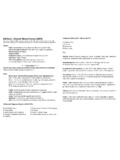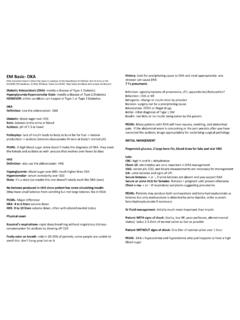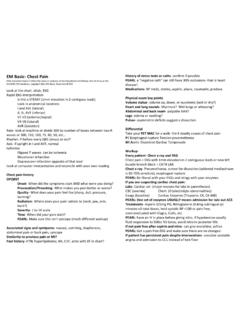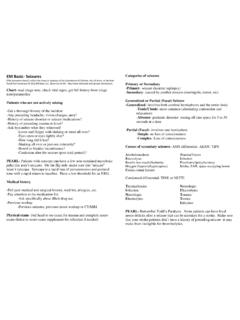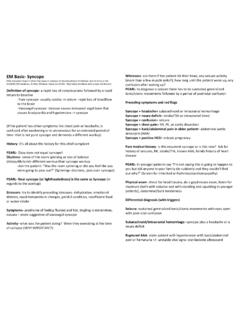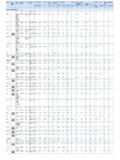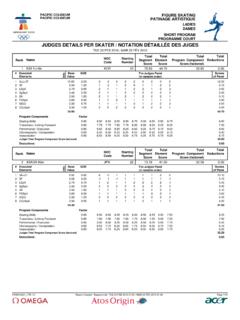Transcription of 60 Sepsis 3.0- Updated March 2017 - EM Basic
1 EM Basic - Sepsis March 2017 - Sepsis - known or suspected source of infection with at least 2 out of 3 qSOFA 2017 EM Basic LLC, Steve Carroll DO. May freely distribute with proper attribution criteria -Hypotension (Systolic BP <90) Recognizing Sepsis -Altered Mental Status -Tachypnea (Respiratory rate of 22 or higher) Vitals- Fever, tachycardia, hypotension, hypoxia, tachypnea -Triage respiratory rates frequently inaccurate PEARL: Remember this with the mnemonic HAT . Technically also an -Look at respiratory effort- fast or increased work of breathing? allowance for an increase in the full SOFA score of 2 points or more- but not really useful in the ED. Also- don't stop a Sepsis resuscitation just because Systolic BP is 95- this is trying to find the sickest Sepsis patients History and Symptoms -Severe Sepsis - now defined as the need to use vasopressors to maintain a Head to Toe recent symptoms/ROS- fever, headache, stiff neck, cough, Mean Arterial Pressure (MAP) of less than 65 AND a lactate of greater than 2 shortness of breath, abdominal pain, urinary symptoms, diarrhea, new after adequate fluid resuscitation AND rashes or bumps, back pain - Adequate is not defined- left up to your judgment Recent procedures?
2 - new port in an oncology patient? New -Also- the AND statement should probably be OR to make sure that nephrostomy tube? Recent surgeries? patients who are on pressors but clear their lactate are still treated aggressively- some patients will clear their lactate but still die! Complete Past Medical and Surgical History Before resuscitating- consider if the patient would be better served by forgoing resuscitation and starting comfort care instead Ask about medications, allergies, recent admissions to the hospital, -Check for advance directives, consider functional status, talk with the recent use of antibiotics patient's family -A healthy 20 year old with bacterial meningitis is much different than a Exam- Full Head to Toe 90 year old patient with dementia in a nursing home with a feeding tube- do the right thing for the patient and their family -Don't forget neuro exam and walking the patient if there is headache, stiff neck or neuro deficits Labs -Examine every inch of the patient's skin (including axilla, groin, peri-rectal -Standard large bore IV access area)
3 For abscesses or cellulitis -CBC, CMP, UA, Urine Culture, Blood Cultures x2, VBG/ABG with lactate -Check lung sounds (pneumonia?) -Check for abdominal tenderness (chole, appy, etc.) Imaging -Overall perfusion- cap refill? Skin pale and/or cool? -Chest x-ray (screen for pneumonia) -Overall picture of the patient- if any patient looks sick they could be septic! -Non-contrast head CT/LP (if suspecting meningitis) New definitions of Sepsis (February 2016) PEARL: Head CT is to look for mass, hemorrhage, and signs of increased -No more severe Sepsis - only Sepsis and septic shock intracranial pressure that could (in theory) cause herniation if an LP is done. Definitely do an CT before LP in patients who are altered, have an abnormal neuro exam, elderly, or immuncompromised. Imaging (continued) -Fluid choice- normal saline ok for the first two liters but risk of hyperchloremic metabolic acidosis with large volumes due to high sodium load- consider -Abdomen/Pelvis CT- if patient complains of abdominal pain and/or has starting or switching to lactated ringer's (LR) or plasmalyte which are closer to abdominal tenderness- use contrast if the patient's kidney function can handle actual physiologic levels of electrolytes it, otherwise get a non-contrast CT Antibiotics -Ultrasound- bedside US can help find cholecystitis quickly, but have a low threshold to get a CT to get the whole picture in the abdomen if needed -Unknown/unsure source Old versus new Sepsis guidelines -Zosyn (piperacillin/tazobactam) and Vancomycin -Zosyn grams IV ( grams ok if more readily available in the ED)
4 -Old guidelines for Early Goal Directed Therapy mandated central and arterial -Give first- can be infused quickly over about 10 minutes lines for all of these patients along with transfusing to hemoglobins of more -Zosyn is a penicillin- keep that in mind with allergies than 10 (after initial volume resuscitation) as well as using dobuatmine -Vancomycin- 15- 20 mg/kg IV of ACTUAL body weight, some advocate -These interventions have been shown by the ARISE, PROCESS, and PROMISE 25-30 mg/kg with a max of 2 grams IV trials to be unnecessary unless the clinician thinks they are needed -Give second- takes at least 2 hours to give -No need for central access unless you need pressors (and these can be started PEARL: 1 gram of vancomycin is not enough unless patient weight 50kg peripherally first), no need for higher hemoglobin thresholds for transfusion (use 7 grams/dl) -Cefepime (cephalosporin) and Vancomycin -Some evidence that Zosyn/Vanc leads to more acute kidney injury Sepsis Treatment -Cefepime- 2 grams IV Fluids PEARL: Cefepime can be used in patients with PCN allergy since it's a 4th generation cephalosporin -Scott Weingart on the EmCrit podcast- You don't have to do a lot of crap, you just have to give a crap - give aggressive care!
5 Known or Suspected Source- LUCAS mnemonic- (Hat tip: Rob Orman from the ErCast podcast)- if you know the source, we can be smarter about abx choices -Immediate IV fluids- at least 30 mls/kg- 2 liters in a typical 70 kilogram male -Lung -2 liters should be a starting point for most patients -Urine -But are we giving too much fluids? Some experts say yes but no good -CNS evidence -Abdomien -Skin -Re-evaluate patients frequently- the question is- would the patient benefit from more fluid? Did their heart rate come down, their blood pressure -Lung source- Pnemonia increase, or do they look more awake or better perfused? -Non-ICU patients- Levaquin (levofloxacin) 750mg IV -Fluid responsiveness- check the website for many resources -ICU and Healthcare Associated Pneumonia (HCAP) -Zosyn/Vanc or Cefepime/Vanc -HCAP criteria- admitted to the hospital for more than 2 days in the last 90 days, resident of a nursing home or long term care facility, patients on dialysis or chemotherapy PEARL: New surviving Sepsis guidelines from 2017 DO NOT recommend routine First line pressor- dopamine is no longer recommended double coverage of pseudomonas with levaquin (in addition to zosyn/vanc or cefepime/vanc) in those patients with HCAP.
6 Levophed (norepinephrine- commonly norepi) -Alpha and beta agonism -Urine -2 mcg/min, maximum of 20-30 mcg/min -Ceftriaxone 1 gram IV- ok to give in patients with PCN allergy -Some will go as high as 1 mcg/kg/min (70 mcg/min) -Generally point of diminishing returns above 20-30 mcg/min PEARL: Depending on local sensitivities, Zosyn frequently has lower effectiveness (80%) against urinary E. Coli versus ceftriaxone (98%). So Zosyn Second line Pressors and call it a day may not work for urinary issues. If urine is a likely source but not yet confirmed, can given cefepime/vanc pending UA results. Vasopressin- especially if patient remains tachy on norepi units per minute PEARL: Check for previous urine culutres for the patient to check the patient's previous antibiotic sensitivities and let that guide your antibiotic choice Epinephrine- especially if the patient has a normal heart rate on norepi -1 10 mcg/min -Central Nervous System- Meningitis - Ceftiraxone 2 grams IV Re-evaluate -Vancomycin 15-20 mg/kg, max 2 grams -After fluids, abx, and pressors on board re-evaluate the patient -Acyclovir 10 mg/kg if suspecting HSV meningitis- history of HSV infection, -Re-check exam- worth of breathing?
7 Signs of fluid overload, perfusion young patient with a new psychotic break status better or worse? Mental Status? -Re-check lactate- is the lactate down by at least 10% in the first hour? -Abdomen- Cholecystitis, appendicitis, ascending cholangitis, complicated -More fluids or pressors to help improve metabolic status? diverticulitis, intra-abdominal abscess -Work of breathing- can be up to 30% of patient's metabolic load in -Zosyn good for chole/appy Sepsis -Cirpo (ciprofloxacin) 400mg and Flagyl (metronidazole) 500 mg IV usually used -Should you consider intubating semi-electively? for diverticulitis and other bowel issues or in cases of PCN allergy -If you do, low dose sedatives, high dose paralytics -Skin- abscesses, cellulitis causing Sepsis Good ongoing critical care (big and small stuff!) -Zosyn/Vanc- especially Vanc if suspecting MRSA (frequently hospitalized, dialysis, chemo patients or history of multiple abscesses in the past) -Head of bed to 30 degrees- improves ventilation, prevents vent associated PNA Vasopressors in Sepsis -Tidal volume 6-8 ml/kg of IDEAL body weigh on vented patients -Generally best to start after sufficient fluid loading -Use a tape measurer to measure sternum to fingertips, multiply by 2- -Start them if MAP <65 after fluid loading.
8 Gives you wingspan which is very close to patient's height- needed to -Good evidence to say you can start pressors peripherally while waiting to calculate IDEAL body weight complete central access -Use a good peripheral- 18 gague in AC or forearm ok- tenous 24 gague -Place arterial line (especially if on pressors) in the hand is not ok -Make sure to check IV sites at least once an hour for extravasation and -Avoid high FiO2 settings (hyperoxia)- wean down FiO2 on vent to keep sats stop the infusion if its detected above 92% Good ongoing critical care (continued) -Use ARDSnet protocols in patients at risk for ARDS -Surgical control of any Sepsis sources like abscesses -Surgical or IR consult as needed (Contact.)

